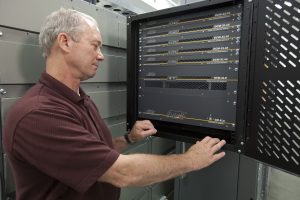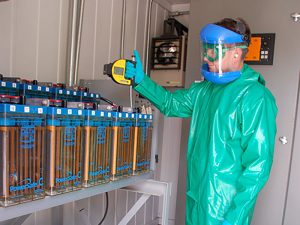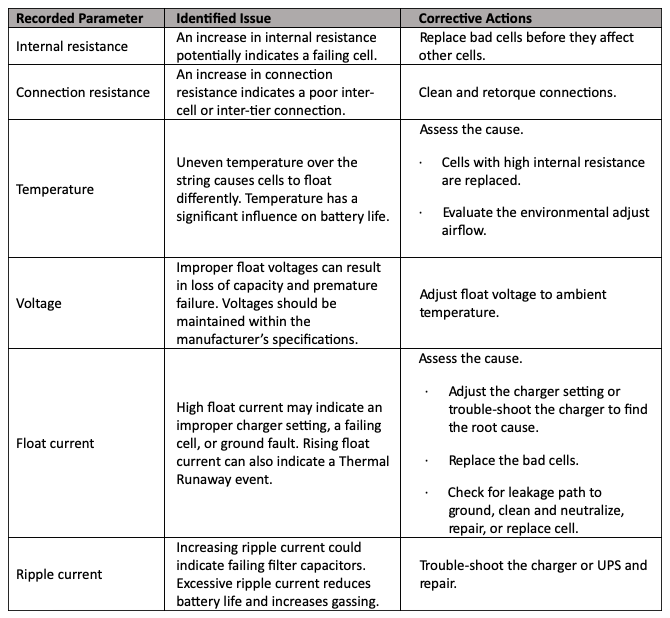By Brandon Schuler, Electrical Reliability Services and Jeff Albér, Vertiv
October 29, 2020 | According to the Electric Power Research Institute (EPRI), 98% of all power outages last less than 10 seconds. Yet, if the uninterruptible power supply (UPS) batteries supporting critical networks, or the battery banks supporting electrical protection and control, emergency, or backup systems fail during those 10 seconds, the consequences can be significant. Personnel safety, equipment, and facility operations are at risk. Damage to reputation and costs to the business can quickly escalate.
Often neglected, DC power systems are critical to ensuring the continuity of an organization’s operation. UPS systems provide a constant, steady flow of clean power to critical equipment and facilities that cannot tolerate even the slightest power fluctuations. Protection and control, emergency, standby, and backup battery systems supply power to safety networks and electrical systems to ensure an ongoing supply of reliable power if there is a power failure or fault.

As critical as they are, DC power systems are vulnerable and often not properly maintained. They are subject to everyday wear and tear that can compromise their effectiveness. They include life-limited components, each with a finite operating life, and can fail unexpectedly. As a result, problems with DC power systems are often the root cause of unplanned downtime for utilities, manufacturers, and commercial businesses. Every system manager is keenly aware that power interruption can be disastrous for their operation and customers. They can also result in critical injuries, costly repairs, and fines for non-compliance with industry standards.
Understanding the Industry Standards on Battery Maintenance
The criticality of battery maintenance is reflected in the many standard recommendations and requirements for UPS, protection and control, emergency, standby, and backup systems. There are multiple industry standards used to inform and develop testing procedures, scope, and frequency of maintenance plans including the North American Electrical Reliability Corporation – NERC PRC-005, the Institute of Electrical and Electronics Engineers – EEE 1188, 450, and 1106, and the International Electrical Testing Association – NETA ATS-2017 and MTS-2019 for different battery types. (Valve-Regulated Lead-Acid – VRLA, Vented Lead-Acid – VLA, Lithium, Nickel Cadmium).
- NERC PRC-005 specifies that generator owners, transmission owners, and distribution providers are required to properly maintain their power and battery backup systems as part of NERC PRC-005 compliance. The challenge utilities face is how to comply with these requirements in a cost-effective and efficient manner. The solution depends on system configuration, geographical distance between facilities, system criticality, and engineering and technical expertise.
- IEEE 1188 specifies maintenance, test schedules, and testing procedures that can be used to optimize the life and performance of VRLA batteries for stationary applications. It also provides guidance to determine when batteries should be replaced.
- IEEE 450 specifies maintenance, test schedules, and testing procedures that can be used to optimize the life and performance of, permanently installed VLA batteries. It also provides guidance to determine when batteries should be replaced. It is applicable to standby service, stationary applications where a charger maintains the battery capacity and supplies the DC loads.
- IEEE 1106 provides recommendations for installation design, installation, maintenance, and testing procedures that can be used to optimize the life and performance of vented nickel-cadmium batteries, including partially recombinant types, used in stationary applications.
- NETA ATS-2017 and MTS-2019 (Standard for Acceptance Testing Specifications and Standard for Maintenance Testing Specifications) specify recommended visual inspections and test intervals for batteries and battery system equipment.
Strategies for DC Power Maintenance

Two of the most commonly practiced strategies for DC Power Maintenance are time-based and performance base-maintenance.
Time-Based Maintenance refers to maintaining or replacing battery cells and systems to restore their performance and reliability at a fixed time, interval, or usage regardless of its condition. The intervals may have been developed from prior experience, manufacturers’ recommendations, or industry-standard specifications. The verification interval also can be based on other factors, including the criticality of the equipment the system supports, past experience with the system, environment, and frequency of operation. Usually, the maintenance intervals are fixed and services are scheduled monthly, quarterly, or annually.
Performance-Based Maintenance programs require auditing processes. These auditing processes utilize monitoring equipment to track the performance of battery systems and require the owner to demonstrate how they analyze findings of performance failures and aberrations and implement continuous improvement actions. A performance-based maintenance process may justify longer maintenance intervals or require shorter intervals relative to a time-based strategy.
Traditionally DC power system maintenance programs have been time-based and include routine periodic maintenance with battery capacity testing intervals based on an established maintenance plan. (NERC PRC-005 requires utilities to have a formalized Power System Maintenance Plan (PSMP) and performance records).
A time-based maintenance strategy is proven to be effective in managing asset health and reducing the risk of failure. A comprehensive preventive maintenance program ensures the proper operation and safety of UPS systems, inverters, battery systems, and battery chargers with regular visual and mechanical inspections on a specified timeframe to address each of these components in the power chain.
Services for UPS systems include thermographic scans, electronics calibrations, and verification of alarm circuits and indicators and alarm history to check for signs of potential problems. Batteries are maintained to extend battery service life and racks are inspected for corrosion, cleanliness, and structural integrity. Battery field services include the following:
- Condition assessments
- Ohmic battery state of health tests
- Battery connection integrity tests
- Float voltage measurements
- Specific gravity readings
- Recording of all testing and measurements
- Corrective actions
A performance-based maintenance strategy provides owners with the most reliable DC power maintenance plan. With the advancement of monitoring technology, asset owners are transitioning to performance-based maintenance programs utilizing a combination of monitoring and maintenance products and services to ensure systems are always compliant and the power is always on. For DC power systems this requires the installation of battery monitoring equipment and 24×7 remote monitoring services, along with an annual maintenance assessment of all monitoring and DC power equipment. The monitoring system provides continuous reporting on the health of the equipment eliminating the need for periodic maintenance assessments. Like an electrocardiogram (EKG), a battery monitoring system alerts system owners of a potential failure that cannot be seen otherwise. By automating the required maintenance tasks, owners can comply with industry standards while increasing system reliability. This maintenance strategy optimizes maintenance budgets and resources by eliminating routine onsite maintenance tasks.
Monitoring systems continuously measure and record critical battery parameters. This data enables the users to make intelligent decisions about their system’s health and to proactively perform corrective action. The following table provides an example of battery monitoring measurements and associated corrective action. Note the table is not inclusive of all key measurements.

Industry standards recognize the unique benefits of monitoring systems that provide ongoing assessment of the DC Power equipment and system. The NERC standard states that no periodic maintenance is required. This is because the monitoring system is designed to flag any irregularities. What is required are regular reviews of the data, trend reporting, and data analyses, along with visual inspections of the system environment, rack, and cell condition.
Vertiv Services field research has shown that utilizing a monitoring system and monitoring specialists to provide around-the-clock battery assessments increase the mean-time between failure (MTBF) by more than double when compared to preventive maintenance alone. Other benefits include
- Maximized total system reliability
- Optimized performance throughout the equipment lifecycle
- Controlled equipment maintenance costs, with lower total maintenance costs
- Automated regulatory compliance
- Reduced power interruptions and increased customer satisfaction
- Improved facility safety
An Overview of Battery Monitoring Technology.
Battery Monitors, Sensors, and Software
The state-of-the-art, battery monitoring products available today are specifically designed to comply with industry standards and recommended practices for battery maintenance. In addition to around-the-clock assessments, they enable remote access to evaluate the condition of the DC systems in hard to get to locations, during storms, or hazardous conditions.
The monitor works in tandem with an electrolyte level sensor to meet the NERC requirements for electrolyte level inspections, reducing the need for onsite inspections and eliminating periodic maintenance intervals. Software can be added to the system to aggregate battery and alarm data from multiple systems and improve monitoring efficiency and reaction times across multiple plants and facilities.
All critical battery parameters are continuously monitored and provide early detection of potential issues when monitored values begin to drift from a benchmark. The automated review of test results provides notification when a threshold is breached. Operators can then use the data to evaluate the real-time health of the equipment and trend performance over-time to predict life-cycle variances.
Not all monitoring systems are created equal. There are many different types of systems that vary in the scope of monitoring functions. Some systems offer a full set of services eliminating the need for additional system maintenance. Other monitoring products may only offer one or two types of assessments, requiring additional field testing to meet standard guidelines. These variances need to be understood when selecting a monitoring system. A battery monitoring system should automate the IEEE recommended practices for battery maintenance and testing, offer multiple remote communication and alarm options, and facilitate complete and accurate maintenance records.
24×7 Battery Monitoring Server
Critical to the effectiveness of a monitoring system is the role of those responsible for reviewing and reporting the data. The monitoring devices are continuously recording data and the data needs to be reviewed and analyzed on an ongoing basis. Engaging an outside remote battery monitoring service to provide around-the-clock trending and analysis of battery monitoring data and alarms, ensures the information is reviewed by trained battery specialists and virtually eliminates the risk of a power system outage due to failed batteries. With 24×7 remote battery monitoring services, experts detect, diagnose, and fix battery issues that may otherwise go unnoticed, preventing them from escalating into major problems.
The installation of a monitoring system with remote monitoring service will help maximize the availability of batteries and overall power systems, extend the service life of the battery systems, and can reduce on-site maintenance costs while increasing battery safety. Emergency service for rapid incident response, as well as monthly trending and reporting for better battery management, should, also, be part of a comprehensive monitoring service program for the best defense against battery-related outages and issues.
The DC power system’s UPS and batteries are some of the most critical and vulnerable components in the power distribution system, causing regulatory agencies to increase specifications for installation and maintenance. Today’s maintenance practices offer a spectrum of UPS and battery system periodic maintenance services and monitoring products and services specifically designed to ensure the reliability of the electrical power chain and meet all compliance requirements throughout the equipment’s lifecycle.
Choosing a maintenance strategy and designing a cost-effective DC power maintenance plan can be challenging with many factors to consider. Because each electrical system has its unique variables, it is a good idea to consult with an expert, an electrical maintenance service provider who will help create a customized program based on the facility’s asset configuration, power requirements and criticality, system environment, and budget parameters.
Brandon Schuler, Manager Industrial DC Power Operations, joined Vertiv’s Electrical Reliability Services team in 2014 and has 20 years of experience in performing and managing electrical/electronics testing and maintenance. Brandon served for eight years in the United States Air Force, trained in Advance Electronics and Electrical Principles, earned several factory-level certifications, and supported several units as a military technician at multiple duty stations. Additionally, he earned an Associate Degree in Electronics Engineering Technology, from Community College, Airforce. As an expert electrical technician and an experienced team leader, Brandon helps customers get the most out of the electrical assets that support their critical processes and systems. He can be reached at Brandon.Schuler@Vertiv.com.
Jeff Albér, VP Business Development Vertiv Battery Monitoring, joined Vertiv in 1997 and has 23 years of experience in the battery testing and maintenance industry. Jeff has an Industrial & Systems Engineer degree from the University of Florida and started his career with Motorola. After 10 years of experience in various engineering roles, he left his Global Commodity Manager position with Motorola Singapore to join Alber/Vertiv. Now as the Alber/Vertiv VP of Business Development, Jeff’s focus is on establishing long-term customer relationships and developing cost-effective battery management solutions that will enable Vertiv customers to efficiently manage their business. He can be reached at Jeff.Albér@Vertiv.com







